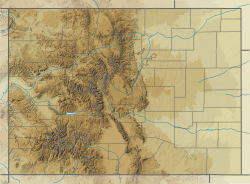| The Fang | |
|---|---|
 The Fang (WI5), March 2015 | |
| Coordinates | 39°38′33.7″N106°19′46.8″W / 39.642694°N 106.329667°W |
| Total height | 165 feet |
| Total width | 26 feet |
The Fang is a 165 foot tall waterfall in Eagle County near the town of Vail, Colorado. It lies in what is called the "Rigid Designator Amphitheatre", which is a significant location in North America for ice climbing and mixed climbing. [1]
